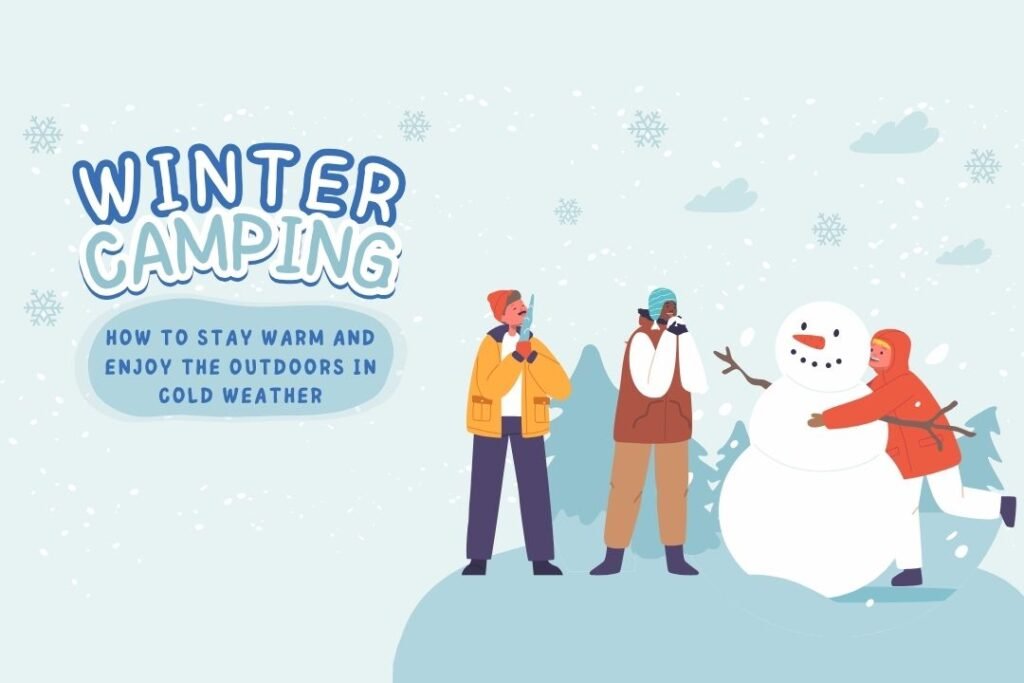Winter camping can be a magical experience. Picture this: serene, snow-covered landscapes, crisp winter air, and no crowds to contend with. However, camping in the cold requires proper preparation and a good understanding of how to stay warm. With the right strategies, you can enjoy winter camping while staying safe, warm, and comfortable. This article will provide expert tips and actionable guidance to help you make the most of your winter camping adventure.
1. Choose the Right Winter Camping Gear
Staying warm during winter camping starts with choosing the right gear. The gear you bring can make or break your experience in cold weather. Here’s what you need to consider:
Winter-Grade Tent
A four-season tent is essential for winter camping. Unlike three-season tents, four-season tents are built to withstand harsh conditions like snow, wind, and freezing temperatures. Look for a tent that has strong poles, minimal mesh to retain heat, and reinforced fabric for insulation.
Sleeping Bag
Your sleeping bag is your primary source of warmth at night. When camping in freezing conditions, opt for a sleeping bag rated at least 10°F lower than the expected night temperatures. Down-filled bags provide excellent warmth-to-weight ratios, but synthetic options are better if there’s moisture.
Sleeping Pad
A good sleeping pad is often overlooked but plays a critical role in insulating you from the cold ground. Use a sleeping pad with an R-value (insulation rating) of at least 4 or 5 for winter camping. You can also double up by using a foam pad beneath an inflatable one for added insulation.
Clothing Layers
Layering is the key to regulating your body temperature. You need three primary layers:
- Base Layer: Moisture-wicking material like merino wool or synthetic fabrics to keep sweat away from your skin.
- Mid Layer: Insulating layer like down or fleece to trap body heat.
- Outer Layer: A waterproof and windproof shell to protect you from the elements.
2. Master the Art of Layering
Layering your clothing is essential for maintaining body heat without overheating or sweating, which can lead to rapid cooling. Here’s how to layer effectively for winter camping:
Base Layer
The base layer should be snug and made of moisture-wicking material like merino wool or polyester. This layer is critical because it pulls sweat away from your body, keeping you dry. Avoid cotton, as it retains moisture and can cause you to get cold quickly.
Mid Layer
The mid layer is your insulation. A down jacket or fleece works best here, as it traps your body heat without adding too much bulk. Down is incredibly efficient in dry conditions, while fleece works well if you expect dampness.
Outer Layer
The outer layer must be waterproof, windproof, and breathable. Look for jackets and pants made from Gore-Tex or other durable, weather-resistant fabrics. This layer will protect you from snow, wind, and moisture while allowing moisture to escape from inside your layers.
3. Food and Hydration for Staying Warm
Your body is like a furnace—it needs fuel to generate heat. When camping in cold weather, you’ll burn more calories, so it’s crucial to eat high-energy foods and stay hydrated.
High-Calorie Foods
Winter camping requires calorie-dense foods like nuts, cheese, chocolate, and dried fruits. These foods provide long-lasting energy. In cold weather, your body burns calories faster, so having snacks on hand is essential.
Hot Meals
Eating hot meals boosts your core temperature and provides much-needed comfort. Bring easy-to-prepare meals like soups, stews, or freeze-dried camping meals. Make sure your stove works well in cold temperatures—some fuels, like butane, can become less effective in freezing conditions, so consider a stove that uses liquid fuel.
Stay Hydrated
It’s easy to forget about hydration in winter since you may not feel as thirsty, but dehydration can accelerate the effects of hypothermia. Carry insulated water bottles to keep your water from freezing, and drink plenty of warm fluids like tea or hot cocoa to stay hydrated and warm.
4. Campfire Tips for Warmth and Safety
A well-built campfire can be the difference between a cold, miserable night and a warm, enjoyable one. However, winter conditions present unique challenges when it comes to starting and maintaining a fire.
Start with Dry Wood
Snow-covered wood can be difficult to ignite. Collect firewood from sheltered areas, such as under trees or tarp covers. Always carry fire-starting materials like waterproof matches, fire starters, and dry kindling to help get your fire going.
Build a Reflective Fire Pit
Position your fire near a large rock or create a wall of logs to reflect the heat back toward your campsite. This will maximize warmth and conserve fuel.
Keep the Fire Safe
Be mindful of where you build your fire. Clear away snow to expose the ground or build your fire on a raised platform. Always extinguish your fire fully before heading to bed.
5. Stay Warm While Sleeping
The night is when the cold can really set in. To stay warm while sleeping, follow these tips:
Preheat Your Sleeping Bag
Before crawling into your sleeping bag, warm it up by placing a hot water bottle inside for about 20 minutes. You can use insulated water bottles filled with boiling water for this purpose.
Wear Clean, Dry Clothes
Always change into fresh, dry clothes before going to bed. Any moisture from sweat will make you cold during the night. Wear thermal underwear, wool socks, and a hat to stay insulated.
Vent Your Tent
While it might seem counterintuitive, slightly venting your tent will prevent condensation from building up inside. Moisture can freeze and make your tent colder, so keep a small vent open to allow airflow.
6. Manage Moisture and Condensation
In winter, staying dry is just as important as staying warm. Moisture from sweat, snow, and condensation can rapidly decrease your body temperature. Here’s how to manage it:
Dry Wet Gear
Wet gear can freeze overnight, making it difficult to put on the next day. Hang damp items near your fire or in a protected area to dry. Never sleep in wet clothing.
Keep Snow Outside
Keep snow out of your tent by setting up a vestibule or using a groundsheet to protect your gear. Brush off any snow from your clothes and boots before entering your tent.
7. Keep Moving During the Day
Cold weather can sap your energy, but staying active will help keep your body warm. Hiking, gathering firewood, or even doing light exercises like squats or lunges can boost your circulation and generate body heat. However, avoid overexerting yourself to the point of sweating, as moisture can cause rapid heat loss.
Conclusion
Winter camping can be an incredibly rewarding experience, offering a unique way to connect with nature. By following the tips outlined above, you can stay warm, dry, and comfortable, allowing you to fully enjoy the serenity of the great outdoors in cold weather. With the right gear, layering, food, and preparation, you’ll be well on your way to mastering the art of winter camping. Embrace the challenge, and let the beauty of winter landscapes enhance your adventure.



